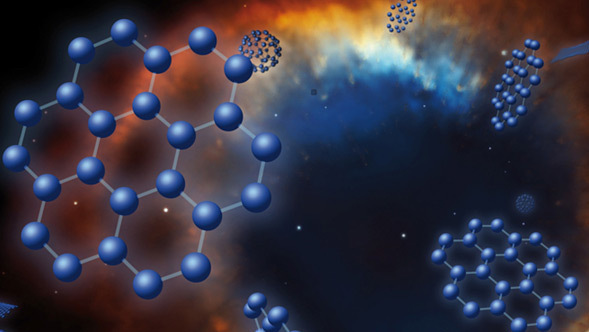
News Release • August 15th, 2011 • feature11-09 •
NASA's Spitzer Space Telescope has spotted the signature of flat carbon flakes, called graphene, in space. If confirmed, this would be the first-ever cosmic detection of the material -- which is arranged like chicken wire in flat sheets that are one atom thick.
Graphene was first synthesized in a lab in 2004, and subsequent research on its unique properties garnered the Nobel Prize in 2010. It's as strong as it is thin, and conducts electricity as well as copper. Some think it's the "material of the future," with applications in computers, screens on electrical devices, solar panels and more.
Graphene in space isn't going to result in any super-fast computers, but researchers are interested in learning more about how it is created. Understanding chemical reactions involving carbon in space may hold clues to how our own carbon-based selves and other life on Earth developed.
Spitzer identified signs of the graphene in two small galaxies outside of our own, called the Magellanic Clouds, specifically in the material shed by dying stars, called planetary nebulae. The infrared-sensing telescope also spotted a related molecule, called C70, in the same region – marking the first detection of this chemical outside our galaxy.
C70 and graphene belong to the fullerene family, which includes molecules called "buckyballs," or C60. These carbon spheres contain 60 carbon atoms arranged like a soccer ball, and were named after their resemblance to the architectural domes of Buckminister Fuller. C70 molecules contain 70 carbon atoms and are longer in shape, more like a rugby ball.
Fullerenes have been found in meteorites carrying extraterrestrial gases, and water has been very recently encapsulated in buckyballs by using new laboratory techniques. These findings suggest fullerenes may have helped transport materials from space to Earth long ago, possibly helping to kick-start life.
Spitzer definitively detected both buckyballs and C70 in space for the first time in July 2010 (see http://www.jpl.nasa.gov/news/news.cfm?release=2010-243). It later spotted buckyballs -- equivalent in mass to 15 full moons -- in the Small Magellanic Cloud. These latter results demonstrated that, contrary to what was previously believed, fullerenes and other complex molecules could form in hydrogen-rich environments (see http://www.jpl.nasa.gov/news/news.cfm?release=2010-351).
According to astronomers, the graphene, buckyballs and C70 might be forming when shock waves generated by dying stars break apart hydrogen-containing carbon grains.
The team that performed the Spitzer research is led by Domingo Aníbal García-Hernández of the Instituto de Astrofísica de Canarias in Spain. The results appear in the Astrophyscial Journal Letters. García-Hernández is also the lead author of the study that used Spitzer to detect heaps of buckyballs in the Small Magellanic Cloud.
Read the news release from the National Optical Astronomy Observatory in Tucson at http://www.noao.edu/news/2011/pr1103.php .



